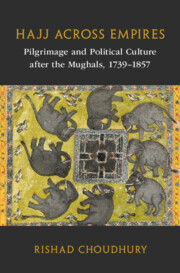Book contents
- Hajj across Empires
- Asian Connections
- Hajj across Empires
- Copyright page
- Dedication
- Epigraph
- Contents
- Figures
- Maps
- Tables
- Preface and Acknowledgments
- Note on Transliterations and Translations
- Abbreviations
- Maps
- Introduction
- Part I Departures
- Part II Crossings
- Part III Returns
- 5 The Company Raj and the Hajjis
- 6 Routes of the Muslim State
- 7 Faqirs and Fanatics, or, Reconfiguring Pilgrimage and Political Culture
- Conclusion
- Bibliography
- Index
- Asian Connections
6 - Routes of the Muslim State
from Part III - Returns
Published online by Cambridge University Press: 01 February 2024
- Hajj across Empires
- Asian Connections
- Hajj across Empires
- Copyright page
- Dedication
- Epigraph
- Contents
- Figures
- Maps
- Tables
- Preface and Acknowledgments
- Note on Transliterations and Translations
- Abbreviations
- Maps
- Introduction
- Part I Departures
- Part II Crossings
- Part III Returns
- 5 The Company Raj and the Hajjis
- 6 Routes of the Muslim State
- 7 Faqirs and Fanatics, or, Reconfiguring Pilgrimage and Political Culture
- Conclusion
- Bibliography
- Index
- Asian Connections
Summary
Focusing on the Mughal successor crown of Arcot and the pilgrimage regimes it shored up from the Karnatak (Carnatic) region, Chapter 6 demonstrates how kingdoms that fell under colonial rule also came to embody new forms of Muslim statehood in India. As a state that cultivated close ties to Arabia even as it was disgorged of its sovereignty by the Company in 1801, the chapter illustrates how the embattled crown of Arcot sought new sources of legitimacy through pilgrimage networks and ceremonials. And yet, as a colonized “treaty kingdom” whose powers and prerogatives were tightly restricted to “religious laws” and “religious institutions” under colonial dominance, the chapter contends that Arcot also began to exclusively emphasize its authority over religious domains to typify a very new kind of Muslim state in India. This in turn led to an implicit if unwitting rejection of the more accommodative political cultures of the Mughals, mainly as it effected a break from earlier ideologies of universal rule. Apart from local courtly chronicles and colonial sources, an Indo-Persian narrative account of the Arcot Nawab Aʿzam Jah’s (r. 1819–1825) royal pilgrimage to a regional “little” Mecca in southern India figures at the heart of this chapter.
- Type
- Chapter
- Information
- Hajj across EmpiresPilgrimage and Political Culture after the Mughals, 1739–1857, pp. 231 - 268Publisher: Cambridge University PressPrint publication year: 2024



